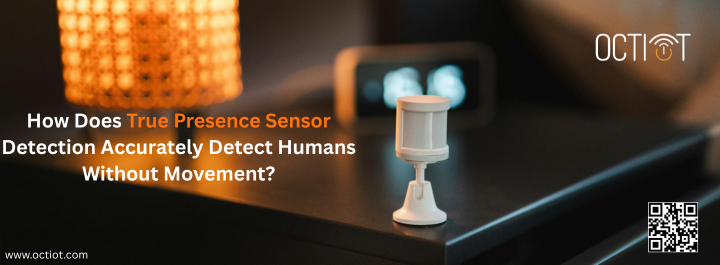Ever walked into a room and the lights turned on without you lifting a finger? That seamless moment of automation is made possible by a powerful yet often overlooked device — the motion sensor.
In a world striving for smarter, greener living, motion sensors play a vital role in reducing energy waste, enhancing security, and improving everyday convenience. At OCTIOT, we design advanced motion sensors and sensor lighting solutions to help reduce electricity bills, cut down carbon emissions, and create smarter environments — all while protecting our planet.
Let’s explore what motion sensors are, how they work, and why they’re essential for modern homes, businesses, and public spaces.

What Is a Motion Sensor?
A motion sensor is a device that detects physical movement in a specific area. When it senses motion — whether it’s a person walking into a room or a car entering a driveway — the sensor triggers a response. This can range from turning on a light to sending an alert to a smart device.
Motion sensors are a foundational component of many smart home and building automation systems. They’re designed to operate efficiently, often without human interaction, ensuring lights or appliances only operate when needed.
Unlike presence sensors (which detect even subtle movements like breathing), motion sensors are generally more responsive to larger movements. This makes them ideal for automated lighting systems, security alerts, and energy-saving devices.

How Does a Motion Sensor Work?
Motion sensors work by detecting changes in their environment — usually caused by movement — and triggering an action. There are several technologies that power motion sensors, and each has unique strengths depending on the application.
1. PIR (Passive Infrared) Sensors
- Detect body heat (infrared radiation) from people, animals, or objects.
- Ideal for indoor environments like hallways, bathrooms, and offices.
- Energy-efficient and cost-effective.
- Common in OCTIOT’s sensor lighting solutions.
2. Microwave Sensors
- Emit microwave pulses and detect changes in reflection caused by movement.
- More sensitive than PIR and can detect through certain materials like glass or walls.
- Suitable for outdoor or large open spaces.
At OCTIOT, we utilise these technologies to ensure every sensor is accurate, fast, and tailored for real-world use — from homes to industrial sites.

Types of Motion Sensors by OCTIOT
We design motion sensors for a variety of applications, ensuring seamless integration into your lifestyle or workplace. Here are the key types of motion sensor lights offered by OCTIOT:
- Ceiling-Mounted Sensors – Perfect for living rooms, corridors, and office spaces.
- Wall-Mounted Sensors – Ideal for driveways, entrances, and garages.
- Daylight Sensors – Automatically adjust based on ambient light levels.
- Occupancy Sensors – Detect when a person enters or leaves a space and control devices accordingly.
- Smart Wi-Fi Motion Sensors – For advanced automation with app-based control.
Each OCTIOT sensor is engineered for efficiency, helping you reduce electricity consumption while keeping your space intelligently lit.

Where Are Motion Sensors Used?
Motion sensors are incredibly versatile and can be used in a wide range of environments:
Residential Spaces
- Bedrooms, hallways, bathrooms, staircases, and kitchens.
- Eliminates the need to manually turn lights on and off.
Commercial Buildings
- Office spaces, conference rooms, lobbies, and elevators.
- Optimises energy usage by lighting areas only when needed.
Industrial and Outdoor Spaces
- Parking lots, warehouses, and loading docks.
- Improves visibility and enhances safety at night.
Public Institutions
- Schools, hospitals, malls, and airports.
- Ensures large facilities operate with energy efficiency.
No matter where they’re used, OCTIOT motion sensors provide intelligent solutions that save energy and simplify everyday tasks.

Why Should You Use Motion Sensors?
Here are the key benefits of installing motion sensors, especially from OCTIOT’s advanced range:
Energy Efficiency
Motion sensors help reduce energy usage by up to 90%. Lights and appliances are only active when needed, preventing unnecessary consumption.
Lower Electricity Bills
Automating your lighting system can drastically cut monthly electricity costs — a win for your wallet and the environment.
Enhanced Comfort
Enjoy hands-free lighting in your home or office. No more fumbling for switches in the dark!
Improved Security
Motion sensors can detect unauthorised movement and trigger alarms or alerts, making them vital for security systems.
Eco-Conscious Living
By using less energy, you directly contribute to lower carbon emissions, aligning with OCTIOT’s mission of building a more sustainable future.
Smart Integration
OCTIOT sensors are compatible with smart home ecosystems, offering app-based control and scheduling options.

Why Choose OCTIOT for Motion Sensor Solutions?
With dozens of options on the market, why trust OCTIOT?
- 🌍 Sustainability First – Our solutions are designed to reduce carbon emissions and promote responsible energy use.
- 💡 Innovation-Driven – We stay ahead of the curve with cutting-edge sensor technology tailored for modern lifestyles.
- 🔒 Reliable & Durable – Built to last, OCTIOT products are rigorously tested for real-world conditions.
- 🧠 Smart by Design – Seamless automation and intelligent features make our systems easy to use and customise.
Final Thoughts
Motion sensors are more than just a convenience — they are the backbone of smart, sustainable environments. Whether you’re looking to automate your home lighting, secure your business, or simply reduce your electricity bill, motion sensors offer a practical, eco-friendly solution. At OCTIOT, we’re committed to transforming everyday spaces with intelligent sensor lighting that saves energy, reduces emissions, and makes your environment smarter.




